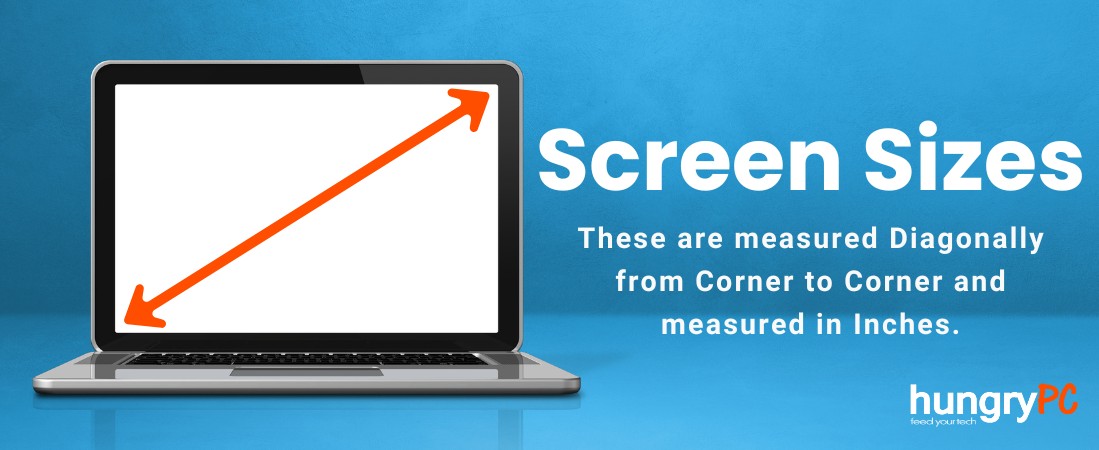One of the most crucial aspects to consider when purchasing your laptop is the screen size. It’s not just about aesthetics as the screen size also determines the overall size and weight of the laptop, and can change how you interact with the laptop on a day to day basis. Whether you’re a student, a business professional, creative artist, or a casual user there is not a “one size fits all” approach, as it mostly comes down to personal preferences, however we have found patterns in the market, and learned from years of experience which devices are most likely to suit peoples needs. So how are laptop screen sizes measured, and which sizes cater best to different user preferences and needs?
How Laptop Screen Sizes Are Measured

Laptop screen sizes are typically measured diagonally from one corner of the screen to the opposite corner, usually the bottom left to the top right. This measurement is expressed in inches and is universally used worldwide. The most common sizes are 12.5″, 14″, 15″ and sometimes 17″ While this provides a standard metric for comparison, it’s important to note that the actual dimensions of the laptop itself can vary significantly based on factors like bezel thickness and aspect ratio.
Popular Laptop Screen Sizes and Their Potential Suitability
12.5 Inch Screens and Under
- Who It’s For: Mostly School Students, and Travelers on a space budget.
- Why: This size laptop is super portable, often very lightweight and easy to fit in a smaller bag, like a school bag or overhead luggage bag for international travelers. The main downside to this size is that typically the screen resolutions are often lower, in order to make sure that items on the screen do not appear too small. In this case you cannot fit so much on the screen at any one time, so you’ll be scrolling more often when browsing the internet for example.
13 to 14 Inch Screens
- Who It’s For: Professionals, Students, and Travelers
- Why: Laptops in this size strike almost a perfect balance between portability and usability. They are lightweight and compact, making them ideal for professionals who are always on the go or students who need to carry their laptops between classes. Additionally, the screen size is sufficient for productivity tasks such as document editing, web browsing, and light photo editing. They are a very popular choice, widely available in a huge range of different laptop models. 14″ would be our preferred choice for an all-round portable, yet feature packed laptop purchase.
15.6 Inches
- Who It’s For: Content Creators, Gamers, and Power Users
- Why: This size offers a larger canvas for content creation and even immersive gaming experiences. Content creators, such as graphic designers and video editors, benefit from the extra screen real estate for multitasking and detailed work. Gamers also appreciate the larger display for better visibility during gameplay. Moreover, power users who require robust performance for demanding tasks find these laptops accommodating. If you’re a home or business user who predominantly has their laptop on a desk, and don’t often travel with it, this would be our recommended size, as it offers a very good compromise between a laptop that you can take with you if you need to, and that of a fully functioning desktop computer system.
17 Inches and Above
- Who It’s For: Desktop Replacements, CAD Design, and Entertainment
- Why: Laptops with screen sizes of 17 inches and above are often referred to as desktop replacements due to their substantial size and weight. They are popular among users who prioritize a large and immersive viewing experience for entertainment purposes, such as watching movies or streaming content. Additionally, professionals in fields like architecture or engineering may opt for these larger laptops for intensive design work. These types of laptops often come packed with very high specifications, more expansion and upgrade options, high end graphics cards etc, as manufacturers can easily pack more hardware inside them.
Optimizing Your Laptop Screen Size Choice
When choosing which laptop to buy, and when you are checking out the laptop screen sizes, consider your specific needs and usage patterns. Here are a few tips to help you make an informed decision:
- Portability vs. Productivity: Balance your need for portability with the desire for a larger screen. If you prioritize mobility, opt for a smaller screen size. However, if productivity or extended periods of use is paramount, consider a larger screen for enhanced multitasking capabilities.
- Resolution Matters: Higher resolution displays offer sharper images and text, regardless of screen size. Factor in resolution along with screen size to ensure a crisp and clear viewing experience. A Full HD (1920×1080) or even 4K resolution screen can be worth the extra investment if you really want an immersive display for movies or gaming.
- Consider the Specs: As manufacturers are always trying to perfect their designs, the laptop screen size often is intended to suit a particular target audience. When manufacturers are considering what size to build the laptop and which size screen to include, this often dictates if the machine will have extra capabilities such as a graphics card for CAD design or Gaming. While more portable 14″ sized laptops often have larger capacity batteries to go along with their portability narrative.
Ultimately understanding how laptop screen sizes are measured and their suitability for different user demographics can help you make an informed decision when purchasing a laptop. Whether you prioritize portability, productivity, or entertainment, there’s a laptop out there to meet your needs. If you are in the market for a laptop but not sure what to choose, you can always consult with our expert team, and we find you the perfect solution to meet your needs.
